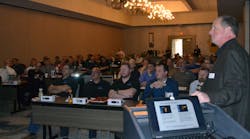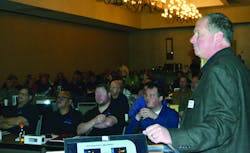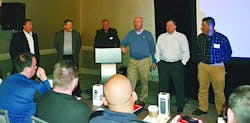A select group of commercial refrigeration service managers and technicians convened in Orlando recently for a meeting of the Institutional and Supermarket Equipment Group (ISE).
ISE — a contractor cooperative founded in 1961 — is a nationwide network of more than 100 professionally qualified contractors who specialize in all facets of refrigeration equipment sales, design, installation and maintenance provided to end-user customers. ISE’s mission is to maximize shareholders value through the products and services offered by ISE.
ISE offers sales and marketing seminars each year to help its shareholder members stay current with the ongoing changes in supermarket refrigeration, network with peers, and share best practices. This event represented a new offering by ISE, which is located in Street Plantation, Fla.
Honeywell was the main sponsor of the meeting, with additional support from co-sponsors Bacharach, Emerson, Heatcraft, Sporlan, and United Refrigeration. A total of 12 vendors participated in a table-top trade show in conjunction with seminar presentations.
ISE President Pat Welty, who is also co-owner of SCR Refrigeration, St.Cloud, Minn., welcomed attendees, and explained the reasoning behind this special meeting for service managers. He said it began during a discussion with Jim Wilson, Honeywell’s North America Sales Manager, about the many changes contractors now face.
“I told Jim how ISE is trying to improve our technician training to go above and beyond an advanced level. Jim and Honeywell quickly agreed to serve as a sponsor for this type of event.”
Welty said the change that’s currently reshaping commercial refrigeration is greater than any he’s ever seen in his 40-year career.
“When I started in this industry, there were three refrigerants: R-12, R-502 and R-22. Today, at our building we have 25 different refrigerants. And on top of that, you have legislative activity, with the EPA and DOE, and some state legislation," Welty said. "All of that is affecting our lives every day. But with all the talent here this week, there are many opportunities to network. We all live the same life every day, whether in California, or Minnesota or Florida.”
Rob Howard, Honeywell’s southeast sales manager, reviewed the major regulations and the changes brought about by those regulations.
“Some of these changes represent opportunities for you to act as a consultant, in addition to maintaining their equipment,” Howard said. The rapid depletion of R-22 is at the top of the list, and Howard said it is imperative that customers move away from R-22 as soon as possible.
Ron Vogl, technical marketing manager for Honeywell Fluorine Products, emphasized the importance of taking action at a critical time. Especially when so many customers’ systems are still charged with R-22.
“Your customers are going to need to know what’s coming, and you’re their contact. With every change, there is opportunity. If you grab hold of it and are aware of what’s going on, there’s a lot of business you can drive from it,” Vogl said. “There are still a lot of R22 installations out there. There are entire store chains that haven’t done a thing, and they have to do something now, in addition to ice rinks, process chillers and other applications.”
Vogl offered a detailed review of the various replacement options Honeywell now provides to contractors and to their customers, for use in a variety of applications. The newest Honeywell refrigerants that are now available include the Solstice® N Series and Solstice® L Series, both of which are HFOs (hydrofluoro-olefins). They both serve as excellent replacements for R-123, R-123a, R-22, R-404A and R-410A in stationary air conditioning, self-contained refrigeration, commercial refrigeration, and certain types of chillers.
Vogl also reviewed Honeywell refrigerant options for industrial air conditioning, industrial heat pumps, industrial refrigeration and industrial ORC applications.
“HFOs and HFO blends are very similar to what you are using today. Anything your technicians are used to, these products will be similar to those in terms of performance and operating pressures and other characteristics,” Vogl said. “You hear a lot now about carbon dioxide, hydrocarbons and ammonia, that those are the only solutions. Each has its place, but if you look at the HFOs and the HFO blends, in anything we’re doing today, I can give you a combination that will fit the application.”
Sachim Arora, global leader for Honeywells’s Fluorine Products commercial new business, presented Honeywell’s “Smart Refrigeration Solutions” to reduce energy consumption, increase equipment reliability, maintain food freshness and reduce unplanned maintenance. He said these ideas were based in part on feedback received from refrigeration contractors and supermarket managers.
Doug Starasinic, technical marketing manager for commercial refrigerants, provided a detailed rundown of retrofitting and commissioning considerations as the industry moves into this new refrigeration age, and retrofits of store systems will absolutely become more prevalent. He described retrofits that involved replacing R402-A, R-408A and R-507 with R-448A, which Honeywell has branded as Solstice N40.
He said a site survey prior to the retrofit is helpful to the supermarket customer who has not yet been through the retrofit process.
“They’re nervous, not sure how it will turn out, or are worried that it will cost too much, or not work. The site survey with the customer alleviates those concerns,” he said.
Starasinic also reviewed proper store retrofit preparation protocol, which includes ordering parts and refrigerant, technician training, performing system changes and upgrades, changing oil from mineral oil to POE, changing suction and liquid filters and driers and more.
Starasinic advised contractors of key retrofit steps when retrofitting with Solstice N40:
• Remind store personnel the day prior to the retrofit
• Secure food safety (dry ice, plastic sheeting, signs on coolers, etc.)
• Recover existing refrigerants
• Record the amount of refrigerant removed, including refrigerant previously removed
• Break vacuum from the recovery machine
• Replace seals, gaskets, and valves
• Replace expansion valves
• Replace driers and filters
• Charge the system with SolsticeN40 refrigerant
• Adjust expansion valves
• Label components and systems
• Commission the system.
For additional information about ISE, visit the organization’s website, at www.iseinc.org.












